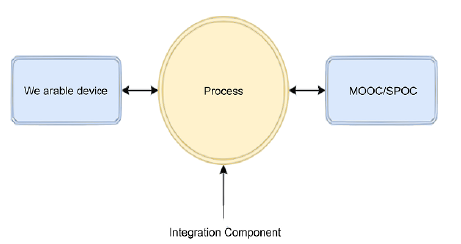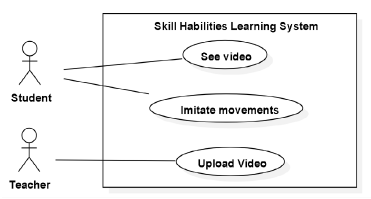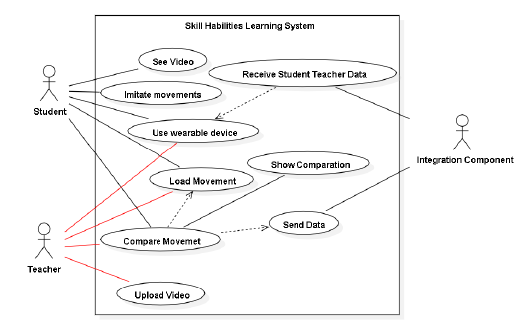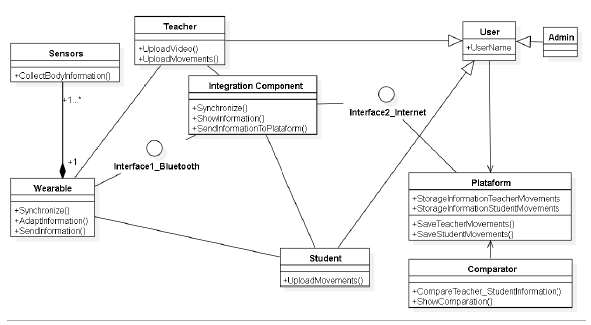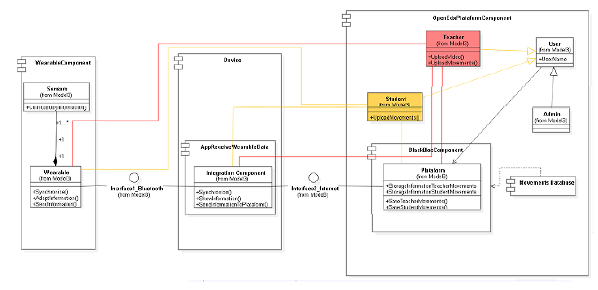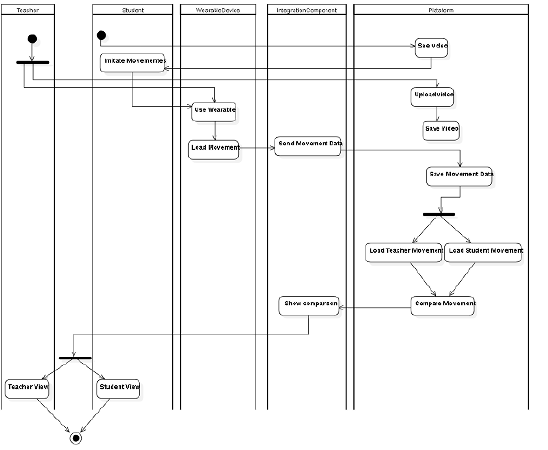INTRODUCTION
The current era makes people develop activities seeking to improve their skills. Nowadays, it becomes necessary to complement the skills learned during the higher education levels and endorse the new knowledge through a recognized academic institution [1]. On the other hand, some people are interested in other types of learning that involve the well-being of those who have them, such as hobbies, physical activities, sports and others [2].
In the processes of teaching and learning motor skills, virtualization makes these types of actions complex and difficult. In most cases, this is done through videos whose indications are supposed to be reproduced by the student. However, it is not possible to provide feedback in this case. That is the reason why the list of courses provided by edX [3] and Coursera [4], for example, are theoretical in nature [5]. Some of them are examples of courses that encourage physical activity but with the above mentioned restrictions.
This leads us to think that it is possible to explore alternatives that imply a bidirectional communication between the person who is interested in learning movements or motor skills and a MOOCs or SPOCs platform. However, the following question arises: How can one carry out bidirectional communication tasks that guarantee feedback in teaching and learning processes that involve movements through the MOOC / SPOC environment?
As a consequence, we can find “wearable” devices which, among other features, have the feature of sending or executing commands at any moment, even when the user is in motion or performing daily activities. Wearable devices can accurately detect the movements of the human body [6]. The characteristics of these wearable devices allow us to think that the processes of teaching or learning motor skills can be supported through them.
It is then considered that it is possible to perform an integration between MOOC/ SPOC and wearable devices through an IoT context. Thus, the following question arises as the basis for an investigation linking both themes: How to extend MOOC or SPOC for learning situations that require motor skills? To answer such a question, the following hypothesis is formulated: “the inclusion of the IoT for teaching or learning with MOOC or SPOC structures expands its possibilities by being supported by wearable technologies in teaching or learning processes in contexts that involve situations that require motor skills”.
1.MATERIALS
1.1 Literature Review
Hargis and Soto [7] mention several topics of interest for this research, such as MOOC, Internet of Things and mobile learning. Although their article relates experiences with different topics and technologies, it is a subject of interest for this research to make an integration between them since the article only mentioned its use and its importance through some examples. On the other hand, the article focuses on theoretical learning topics and does not take into account learning motor skills, a central theme in the purpose of this research.
In another article [8], the authors developed an application based on Android Wear for SmartWatches, designed to receive MOOC notifications and a specific section in the Google Course Builder interface that allows instructors to configure and send messages to each user registered in the course. Although they do use wearables, these are only used to receive notifications, but they are not used to detect or capture data on the movements made by students who need to learn motor skills.
The article by Ovesleová [9] points out that modern technologies expand the structure of users and their learning activities, which logically generates a call for a better personalization of the learning environment. The article examines the role played by user interface in the learning process and also which management system requirements reflect the educational process. The paper provides tools to evaluate the different user interfaces that can be used in virtual educational processes. Although the article does not adequately discuss experiences in which situations that involve movements are evaluated, it can provide important information about the characteristics that an appropriate user interface should have.
There are also several articles by Buchemen and others who are carrying out a project that aims at promoting physical activity for the elderly through virtual courses and wearable devices.
Thus, they propose the fitness MOOC (fMOOC) [10], shown as a result of the intersection between three areas: technology, health and learning. To achieve this, they developed a whole architecture. In this case, they propose the usage of wearable devices. This combination between wearables and MOOC is made through what they call WELL (Wearable Enhanced Learning), defined as the relationship between wearable devices and students.
Likewise, Buchem [11] indicates that wearable devices can be perfectly integrated into daily activities to promote physical fitness. The article presents a new approach to the Design of the Wearable Enhanced Learning (WELL) as related to healthy aging, as a part of the “MOOC Fitness Project - Interaction of the Elderly with Wearable Fitness Tracker in MOOC (fMOOC)”. The article focuses on gamification designs in enhanced learning and addresses the issue of user participation.
Buchem finally [8] proposes an adaptation of a standard user experience model for the learning and instructional design context and describes how the methods to designate user participation have been applied to five different levels in the fMOOC project.
These articles present an approximation to what is being researched here, but it is necessary to adjust these findings to the very requirements involved by movement capture and the use of data generated in this context.
1.2 Investigative proposal
From the reviewed literature, it was devised that there is an opportunity for research in the area of online education in the field of learning and teaching motor skills. More specifically, for the area covered by MOOC in relation to virtual education and IoT through wearable devices. The following is an architectural proposal intended to be used as a basis for an integration that involves MOOC and wearable devices. In this case, “open edX” was selected because of its capacity of being connected to new applications through the XBlocks, and the idea is to receive the data provided by a wearable device in open edX and then process it in such a way that it is possible to provide information both for instructors and students of a MOOC, therefore allowing monitoring, giving feedback and evaluating motor skills.
2. METHODOLOGY
In order to develop this research, three components that show the operation of the system in a high-level view were used as starting points. Namely: the integration component, the wearable component, and the MOOC/SPOC component or the Open edX platform component. Out of these components, a software architecture developed by means of the 4+1 view model was consolidated [12].
2.1 Integration component
The integration component is intended to be an interface from the user’s side, receiving the data sent by the wearable device, performing some kind of processing and finally sending this data to the MOOC platform ( figure 1. System Components).
The integration component is intended to be used through a mobile device (tablet or smartphone) that is connected through Bluetooth to the wearable device. This component receives the data generated by the user and, after preliminary processing, the data is sent to a MOOC platform. In this case, the processing power of the mobile device is used and interaction with the user is provided through an application.
2.2 Wearable component
The wearable component is responsible for obtaining data on the movements made by using sensors located on the user’s body, for detecting these movements and for transmitting them via Bluetooth to the integration component. The prototype to be developed will allow detecting the movements made by the users so that they can be applied to a virtual “salsa dance” course, which will be developed as a future case study of this research. For this case study, it was then decided to capture feet and/or leg movements.
2.3 Open edX component
Open edX has proven to be a stable, robust, and reliable platform [13]. It also has what is called XBlocks. In educational applications, XBlocks can be used to represent individual problems, videos in text and web format, simulations and interactive laboratories or collaborative learning experiences that allow the development of functional extensions, as well as integrating them into open edX platforms. Xblocks can be used in applications that need multiple independent components and can also be used to display those components in a single web page. Then, through open edX and X-Blocks, there is the intention of making an extension to the MOOC platform that is capable of receiving the information sent through the integration component, which is then processed and stored for feedback, evaluation and monitoring.
3. RESULTS
3.1 Architecture
The teaching and learning of motor skills is made, in a general way, through videos in a unidirectional way where a teacher hosts a video afterwards watched by a student who imitates the movements made on the video.Figure 2 summarizes the conventional operation of these systems in a use case diagram.
3.2 Requirement’s analysis
In this case, the hope is that the implemented system achieves a bidirectional communication, providing greater interaction in teaching and learning motor skills, in particular, the salsa dance. Thus, the following requirements for the system are needed:
The system must record the user’s movements, both for the teacher and for the student.
The system must send the recorded data to a MOOC platform.
The system must store the data collected on the movements.
The system must compare the movements sent by the student to those sent by the teacher.
The system must show the results of the comparison for both the student and the teacher.
3.3 High level architecture
The high-level architectural proposal that is shown in figure 3 is used as a starting point. This figure shows the student using a wearable device. This wearable device sends information through Bluetooth, which is received by the integration component, consisting of a tablet or a smartphone. Apart from receiving the initial information, it also interacts with the user. Once this information is available, it is then sent over the Internet to the open edX component, which receives the information with the help of an XBlock. This information is used to monitor the user to give feedback and to evaluate progress. Finally, the users can access their progress on a web environment, either on a computer or on a mobile device.
4. RESULT
4.1 Architecture based on the 4+1 view model
Scenario view:figure 4 summarizes the operation of the system where 3 actors are presented: the student, the teacher and the integration component. The diagram shows that the teacher uploads a video and loads his movements by using a wearable device. In the same way, the student also uses the wearable device and records the movements by imitating the movements seen on the video. Once the movements are recorded, they are then sent through the integration component so that they can be compared, and this comparison can be shown for both the student and the teacher.
Logical view: This view shows the system functionality through figure 5 and figure 6. The sequence diagram shows that the system starts when the teacher uploads a video into the system and loads the movements. The data generated by the teacher’s movements are sent through the integration component and saved for later use. Then, the student uses the wearable device to capture the data generated when imitating the movements, he sees on the video. Through the wearable device, this data is sent to the integration component, and it is then stored. The teacher’s and the student’s stored data is compared and the results of the comparison are shown both to the teacher and the student.
Figure 6 shows the system classes diagram, where we can find the sensor class, responsible for collecting the movement data. The wearable class must be synchronized to receive and transfer data to adapt the information so that it can be sent and, finally, send the data via Bluetooth. The integration component class must be synchronized with the wearable class; it must show the information and send the information to the platform. This class is related to the platform class through the internet. The platform class must store the information generated by the teacher and the student. This stored information is used by the comparison class, so that it can be compared and displayed. Finally, we have the user class, which inherits attributes from three classes: admin, teacher and student. These are the ones responsible for loading the movements to the system.
Development view: In this case (figure 7), the classes are observed in three main components: the wearable component, the device component and the Open Edx Platform component, which are expected to be developed independently and with low codependency between them, thus allowing their independent development. The wearable component contains sensors that can be accelerometers and/or gyroscopes. Likewise, this component contains a wearable device that will be worn by the user and that must be able to capture the information on the movements made by the user. The device component will be developed through an application for a mobile device, initially for Android. It should serve as a gateway between the wearable component and the Open edX Platform component. It must also provide the user with an adequate interface in which the data obtained, and its results can be displayed. Finally, the Open edX Platform component is responsible for collecting the information stored in a database and it is also where all the processing must be carried out, culminating in the comparison of such movement to another one previously stored in the platform. In this case, the communication between the wearable component and the device component will be done through Bluetooth Low Energy. And the communication between the device component and the Open edX Platform component will be done over the Internet.
Process view: In this case, figure 8 shows the dynamic aspects of the system, and the process starts with the teacher uploading an instructional video. Then, the teacher uses the wearable device to upload the movements to the system and these are then sent through the integration component to the platform. In turn, the student also loads his movements with the wearable device and these movements are sent to the platform through the integration component. For both cases, the movements are stored on the platform. Both movements are loaded by the system in order to be compared and, once compared, they are shown by the integration to the student or to the teacher, as applicable.
Physical view:figure 9 shows the physical deployment of the system with the wearable device that communicates via Bluetooth with the integration component hosted on a smartphone or tablet which, on its turn, communicates through the internet with the platform and is hosted on a server. It should be noticed that the results of the comparison are shown through a web interface.
5. DISCUSSION
MOOC/SPOCs have great importance in current online education but, in spite of their great acceptance and relevance, the courses are limited to theoretical contents. Although there are cases of courses of this type that promote physical activity, their interaction in this sense is quite limited. There is therefore a research opportunity on how to teach motor skills in the field of online education through MOOC or SPOC.
A review on the literature that shows the validity of researching issues concerning wearable devices and MOOC/SPOC devices was conducted. Several articles were found, covering topics such as user interfaces, use of technologies in online education and use of devices to complement teaching and learning processes. But in spite of these articles, there is a research gap in learning motor skills with high interactivity through MOOC or SPOC.
Afterwards, a research proposal was suggested, linking the IoT and MOOC/ SPOC with teaching and learning motor skills. Three working blocks were suggested: an integration component, a Wearable component and an Open edX component with XBlocks.
Finally, based on the requirements analyzed for this case, an architecture based on the 4+1 view model was suggested, summarizing and showing the different structures that can be generated for the development of this system. These are the logical, the developmental, the functional and the physical structures, related to each other through a scenario view.
It should be stressed that, as the research is developed, the search for the devices and how to use them to capture the movements will constitute the greatest challenges along with the algorithm necessary to make the comparisons between the data generated from the movements which can be complemented to the very structures of MOOC/SPOC.
6. CONCLUSIONS
Literature reviews show that several papers are directed to use wearable devices to captures data associated with people’s motor skill abilities. Most papers focus on monitoring and alerts to develop physical activities. On the other hand, MOOCs courses to motor skills are developed over recognized platforms how EdX or Coursera when the courses have theoretical content. These two characteristics show that exists a research gap with high potential to search for ways to do feedback in virtual courses that involve motor skills people abilities.
EdX platform introduces an opportunity to develop for having open-source characteristics and use Xblocs. Xblocs allows plasticity and adaptability to receive data generated from motor skill abilities or for embedding applications required in virtual platforms to data management.
Three components are proposed for adaptation, the wearable component, the integration component, and MOOC/SPOC component. The wearable component collects data. The integration component sends information collected to a virtual platform. And finally, MOOC/SPOOC component processes information and shows results.
Finally, 5+1 views architecture shows system proposed functionality and guide system deploy how initial point for research about human motor skill data capture with wearable device for feedback in a virtual education environment.














